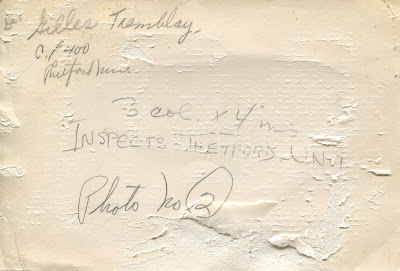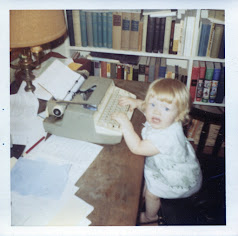This album, according to the backs of the photos I removed, was put together by my mother in January of 1973. I should have known it was from the 70s - fake wood, it wasn't just for station wagons!
Where I had many photos of the same quality in the last album and all taken within two years, this time there were photos spanning at least forty years. The quality of the paper on which they were printed was also all over the map, only a few photos at the end were taken at the same occasion.
The other complication was the size. The pages were square and larger than the bed of my scanner. This was letting light in when I tried to scan the photos in-place. After scanning the first page and getting some awful results, I made the decision not to scan the photos in-place for this album unless there were no other way.
So, my first lesson was that if I wasn't going to scan first, I should have been a bit more careful in removing the photos. I have another larger copy of this photo but without the decorative edges. I love old photos like this but the paper was so very thin. I started with the micro spatula, then tried no-wax floss and got nowhere and then went back to the spatula. Just as I was saying to myself that I should stop because this photo was clearly fused to the page, I did some damage (lower left corner).
My next lesson was that glossy photos on thin paper may show marks from the micro spatula. Unfortunately I wasn't able to get a clear picture of the photo to show you. Even though I was trying to keep the pressure from the spatula directed downward to the album page, I noticed that one photo I was working on was getting marked just from having the spatula pass underneath because the paper was very thin and it was firmly embedded in the adhesive. The digital scan didn't show the marks, thank goodness, but it is something to be aware of.
The last thing I learned with this album is that sometimes you just have to make a judgement call depending on your personal goals.
I'm fortunate to have photographs of my grandfather in wartime. During World War II he was commanding officer of a battalion of engineers who did important and sometimes dangerous work. I was a little anxious to work on these photos, but the reward was great when I found writing on the backs of most of them.
This photo was no different and although it had some existing condition issues, I didn't want to damage it any further. Oh, well! Again, just as I was thinking the micro spatula might not be the best tool for this photo, it ripped right through. Undeterred, I got out some waxed floss. I made a bit of progress with that, right before the floss ripped one of the edges. So, now, obviously, there was a decision to be made.
I decided to remove all of the other photos from this page and then cut the page around the photo so that the photo could be scanned. Once I did that, more of the photo began to peel away and I could see that there was writing on the back. I wanted the information and I had already damaged the photo so I decided to proceed as carefully as possible, which did get me the information and did not further damage the photo.
On to the next album, I'll let you know how that goes.
I'm fortunate to have photographs of my grandfather in wartime. During World War II he was commanding officer of a battalion of engineers who did important and sometimes dangerous work. I was a little anxious to work on these photos, but the reward was great when I found writing on the backs of most of them.
This photo was no different and although it had some existing condition issues, I didn't want to damage it any further. Oh, well! Again, just as I was thinking the micro spatula might not be the best tool for this photo, it ripped right through. Undeterred, I got out some waxed floss. I made a bit of progress with that, right before the floss ripped one of the edges. So, now, obviously, there was a decision to be made.
I decided to remove all of the other photos from this page and then cut the page around the photo so that the photo could be scanned. Once I did that, more of the photo began to peel away and I could see that there was writing on the back. I wanted the information and I had already damaged the photo so I decided to proceed as carefully as possible, which did get me the information and did not further damage the photo.
On to the next album, I'll let you know how that goes.



































